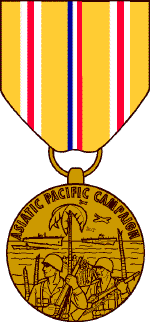Asiatic–Pacific Campaign Medal
| Asiatic-Pacific Campaign Medal | |
|---|---|
 Asiatic-Pacific Campaign Medal | |
| Type | Service medal |
| Eligibility | Served in the U.S. armed forces for at least 30 days in the Asiatic-Pacific Theater between December 7, 1941 and March 2, 1946. |
| Status | Inactive |
| Precedence | |
| Equivalent | American Campaign Medal European-African-Middle Eastern Campaign Medal |
The Asiatic–Pacific Campaign Medal[1] is a United States military award of the Second World War, which was awarded to any member of the United States Armed Forces who served in the Asiatic-Pacific Theater from 1941 to 1945. The medal was created on November 6, 1942 by Executive Order 9265[2] issued by President Franklin D. Roosevelt. The medal was designed by Thomas Hudson Jones; the reverse side was designed by Adolph Alexander Weinman which is the same design as used on the reverse of the American Campaign Medal and European-African-Middle Eastern Campaign Medal.
There were 21 Army and 48 Navy-Marine Corps official campaigns of the Pacific Theater, denoted on the suspension and service ribbon of the medal by service stars which also were called "battle stars"; some Navy construction battalion units issued the medal with Arabic numerals. The Arrowhead device is authorized for those campaigns which involved participation in amphibious assault landings. The Fleet Marine Force Combat Operation Insignia is also authorized for wear on the medal for Navy service members who participated in combat while assigned to a Marine Corps unit. The flag colors of the United States and Japan are visible in the ribbon.
The Asiatic–Pacific Campaign Medal was first issued as a service ribbon in 1942. A full medal was authorized in 1947, the first of which was presented to General of the Army Douglas MacArthur. The European Theater equivalent of the medal was known as the European-African-Middle Eastern Campaign Medal.
Boundaries of Asiatic-Pacific Theater. (1) The eastern boundary is coincident with the western boundary of the American Theater. (2) The western boundary is from the North Pole south along the 60th meridian east longitude to its intersection with the east boundary of Iran, then south along the Iran boundary to the Gulf of Oman and the intersection of the 60th meridian east longitude, then south along the 60th meridian east longitude to the South Pole.[3]
U.S. Army campaigns
Authorized Army military campaigns for the Pacific Theater are as follows:[4]
U.S. Navy campaigns
Authorized Navy military campaigns for the Pacific Theater are as follows:[5]
Other campaigns
For members of the U.S. military who did not receive campaign credit, but still served on active duty in the Pacific Theater, the following “blanket” campaigns are authorized for which the Asiatic-Pacific Campaign Medal is awarded without service stars.
- Antisubmarine December 7, 1941 – September 2, 1945
- Ground Combat: December 7, 1941 – September 2, 1945
- Air Combat: December 7, 1941 – September 2, 1945
See also
References
- ^ 578.49 Asiatic-Pacific Campaign Medal
- ^ *Federal Register for Executive Order 9265
- ^ [1] Army Regulation 600–8–22
- ^ Asiatic-Pacific Campaign Medal description, Clothing and Insignia PSID, US Army TACOM
- ^ Navy and Marine Corps Awards Manual, NAVPERS 15,790 (REV.1953), Part III. - List of Authorized Operations and Engagements, ASIATIC-PACIFIC AREA